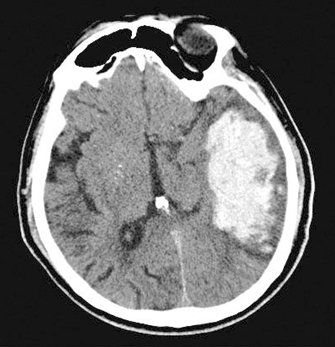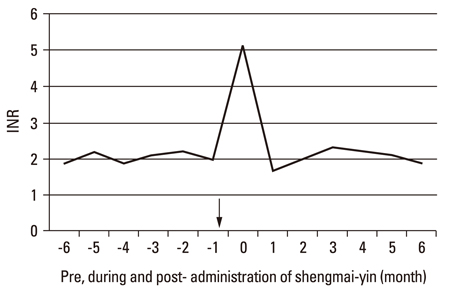Yonsei Med J.
2010 Sep;51(5):793-796. 10.3349/ymj.2010.51.5.793.
Interaction between Warfarin and the Herbal Product Shengmai-Yin: A Case Report of Intracerebral Hematoma
- Affiliations
-
- 1Intensive Care Unit, First Affiliated Hospital, School of Medicine, Zhejiang University, Hangzhou, China.
- 2Department of Anesthesiology, First Affiliated Hospital, School of Medicine, Zhejiang University, Hangzhou, China. yuh_li@hotmail.com
- KMID: 1071437
- DOI: http://doi.org/10.3349/ymj.2010.51.5.793
Abstract
- A 71-year-old man was stable on warfarin (2.25 mg daily) therapy with an international normalized ratio (INR) of 1.8-2.2 after a heart valve replacement surgery. Recently, he consumed the liquid-like herbal product called shengmai-yin (10 mL daily) against medical advice. Seven days after the daily consumption of shengmai-yin, he was admitted to the intensive care unit because of consciousness disturbance [Glasgow Coma Scale (GCS) score 7] with an INR of 5.08. Head computed topography revealed intracerebral hematoma in the left temporoparietal region. Both warfarin therapy and the herbal product were withdrawn. At the same time, therapy with intravenous vitamin K1 40 mg was started. On the second day of admission, craniectomy was performed to remove the intacerebral hematoma under general anesthesia. He remained confused and restless for 2 days, but then showed progressive recovery in the consciousness level as well as motor and verbal functions. Shengmai-yin contains herbal ingredients that can interact with warfarin. The Drug Interaction Probability Scale (DIPS) indicated that warfarin and shengmai-yin were highly probable causes of intracerebral hematoma. Patients on warfarin therapy should be discouraged from taking herbal medicines, especially preparations that are already known to have antiplatelet and antithrombotic effects.
Keyword
MeSH Terms
-
Aged
Anticoagulants/*adverse effects/therapeutic use
Cerebral Hemorrhage/*chemically induced/drug therapy/surgery
Drug Interactions
Drugs, Chinese Herbal/*adverse effects
Hematoma/*chemically induced/drug therapy/surgery
Humans
Male
Treatment Outcome
Vitamin K 1/therapeutic use
Warfarin/*adverse effects/*therapeutic use
Figure
Reference
-
1. Vaes LP, Chyka PA. Interactions of warfarin with garlic, ginger, ginkgo, or ginseng: nature of the evidence. Ann Pharmacother. 2000. 34:1478–1482.
Article2. Xuejiang W, Magara T, Konishi T. Prevention and repair of cerebral ischemia-reperfusion injury by Chinese herbal medicine, shengmai san, in rats. Free Radic Res. 1999. 31:449–455.
Article3. Hu RC, Dai AG, Tan SX. Shengmai injection improves the cardiorespiratory function of catabasis of chronic cor pulmonale patients. J Shanxi Med Univ. 2005. 36:603–605.4. Zhang YC, Chen RM, Zhao MH. [Effect of shengmai injection on hemodynamics in patients with dilated cardiomyopathy.]. Zhongguo Zhong Xi Yi Jie He Za Zhi. 2002. 22:227–229.5. Horn JR, Hansten PD, Chan LN. Proposal for a new tool to evaluate drug interaction cases. Ann Pharmacother. 2007. 41:674–680.
Article6. Wang NL, Chang CK, Liou YL, Lin CL, Lin MT. Shengmai San, a Chinese herbal medicine protects against rat heat stroke by reducing inflammatory cytokines and nitric oxide formation. J Pharmacol Sci. 2005. 98:1–7.
Article7. Wang NL, Liou YL, Lin MT, Lin CL, Chang CK. Chinese herbal medicine, Shengmai San, is effective for improving circulatory shock and oxidative damage in the brain during heatstroke. J Pharmacol Sci. 2005. 97:253–265.
Article8. Ding XF, Chen G, Liu YL. [Effect of shengmai for injection on cardiogenic shock.]. Zhongguo Zhong Yao Za Zhi. 2007. 32:2298–2305.9. Chen GY, Chen EP. HPLC-ELSD determination of ginsenoside Rg1, Re and Rb1 in red ginseng. China J Phar Anal. 2007. 27:754–756.10. Jin YR, Yu JY, Lee JJ, You SH, Chung JH, Noh JY, et al. Antithrombotic and antiplatelet activities of Korean red ginseng extract. Basic Clin Pharmacol Toxicol. 2007. 100:170–175.11. Yun YP, Do JH, Ko SR, Ryu SY, Kim JH, Song HC, et al. Effects of Korean red ginseng and its mixed prescription on the high molecular weight dextran-induced blood stasis in rats and human platelet aggregation. J Ethnopharmacol. 2001. 77:259–264.
Article12. Nakajima S, Uchiyama Y, Yoshida K, Mizukawa H, Haruki E. The effects of ginseng radix rubra on human vascular endothelial cells. Am J Chin Med. 1998. 26:365–373.
Article13. Matsuda H, Namba K, Fukuda S, Tani T, Kubo M. Pharmacological study on Panax ginseng C. A. Meyer. IV. Effects of red ginseng on experimental disseminated intravascular coagulation. (3). Effect of ginsenoside-Ro on the blood coagulative and fibrinolytic system. Chem Pharm Bull (Tokyo). 1986. 34:2100–2104.
Article14. Lü JP, Ma ZC, Yang J, Huang J, Wang SR, Wang SQ. Ginsenoside Rg1-induced alterations in gene expression in TNF-alpha stimulated endothelial cells. Chin Med J (Engl). 2004. 117:871–876.15. Jiang X, Williams KM, Liauw WS, Ammit AJ, Roufogalis BD, Duke CC, et al. Effect of St John's wort and ginseng on the pharmacokinetics and pharmacodynamics of warfarin in healthy subjects. Br J Clin Pharmacol. 2004. 57:592–599.
Article16. Lee SH, Ahn YM, Ahn SY, Doo HK, Lee BC. Interaction between warfarin and Panax ginseng in ischemic stroke patients. J Altern Complement Med. 2008. 14:715–721.
Article17. Jiang X, Blair EY, McLachlan AJ. Investigation of the effects of herbal medicines on warfarin response in healthy subjects: a population pharmacokinetic-pharmacodynamic modeling approach. J Clin Pharmacol. 2006. 46:1370–1378.18. Yuan CS, Wei G, Dey L, Karrison T, Nahlik L, Maleckar S, et al. Brief communication: American ginseng reduces warfarin's effect in healthy patients: a randomized, controlled Trial. Ann Intern Med. 2004. 141:23–27.19. Zhu M, Chan KW, Ng LS, Chang Q, Chang S, Li RC. Possible influences of ginseng on the pharmacokinetics and pharmacodynamics of warfarin in rats. J Pharm Pharmacol. 1999. 51:175–180.
Article20. Mu Y, Zhang J, Zhang S, Zhou HH, Toma D, Ren S, et al. Traditional Chinese medicines Wu Wei Zi (Schisandra chinensis Baill) and Gan Cao (Glycyrrhiza uralensis Fisch) activate pregnane X receptor and increase warfarin clearance in rats. J Pharmacol Exp Ther. 2006. 316:1369–1377.
Article21. Yadav YR, Mukerji G, Shenoy R, Basoor A, Jain G, Nelson A. Endoscopic management of hypertensive intraventricular haemorrhage with obstructive hydrocephalus. BMC Neurol. 2007. 7:1.
Article
- Full Text Links
- Actions
-
Cited
- CITED
-
- Close
- Share
- Similar articles
-
- Delayed Multiple Intracerebral Hemorrhage After Burr Hole Drainage of Chronic Subdural Hematoma During Failure of Warfarin Resumption in Atrial Fibrillation
- Warfarin-Induced Intracerebral Hemorrhage Associated with Microbleeds
- Jejunal Intramural Hematoma with Bowel Obstruction in a 5-year-old Boy: A Case Report
- The Use of Urokinase in Traumatic Intracerebral Hematoma Treatment
- Intracerebral Hematoma Caused by Ruptured Traumatic Pseudoaneurysm of the Middle Meningeal Artery: A Case Report



